
International Research Journal of Engineering and Technology (IRJET) e-ISSN: 2395-0056
Volume: 11 Issue: 07 | July 2024 www.irjet.net p-ISSN: 2395-0072


International Research Journal of Engineering and Technology (IRJET) e-ISSN: 2395-0056
Volume: 11 Issue: 07 | July 2024 www.irjet.net p-ISSN: 2395-0072
Kimaya Malekar
Dept. of Electronics and Computer Science, Thakur College of Engineering and Technology, Maharashtra, India ***
Abstract - This paper is a comprehensive analysis on the general application of Music Therapy , specifically pertaining to the effect it has on one’s mind. It consists of a thorough review of other renowned research papers and all the physical, mental , emotional and biological aspects along with the importance of studying more about it. Lastly, it discusses some techniques and implications for future research.
Key Words- Music Therapy , CBMT ,CBT, Depression , Anxiety, Post Traumatic Stress Disorder (PTSD),Schizophrenia, PANSS.
1.INTRODUCTION
Music Therapy is a practice of using music as a tool to improve the lives of people suffering from mental and emotional stresses. Often thought to be a newly invented method, it has actually existed for centuries now. Widely practiced across different cultures with their own system andbeliefs,theearliestreferenceisknowntohaveappeared inthelate18thcentury.Thenthe19thcenturywaswhenthe practicebecamemoreprevalent.Itwasaroundthattimethe firstknownexperimentwasperformedtoimprovemental health of the patients where a psychiatrist used music to ‘heal’ them in a way. E.Thayer Gaston also known as the “fatherofmusictherapy”provedtobeaprominentfigureby actingasacatalysttomovetheprofessionforwardinterms oforganizationandeducationofthepeople.MichiganState University was the first one to introduce a music therapy collegeprogramintheyear1944.Thiswasshortlyfollowed by other educational institutions like Chicago Musical College,UniversityOfKansas,AlvernoCollegeetc.
Differenttypesofmusictherapy:
1. Benenzon Music Therapy : It is a combination of psychoanalysisandmusicmaking.Itbasicallysearchesfor your “ sound identity” trying to match an external sound withsoundofyoursubconscious.
2. Analytical MusicTherapy:Itincludesuseofyour voiceforsingingasongorplayinganinstrumentthatwill bringoutyourthoughtsandwhatisgoingoninyourmind.It is a way of expressing without actually talking but rather takingthehelpofmusic.
3. Community Music Therapy : Considered to be a group activity where people sit in a group where music
therapyisnotonlydirectedtowardsanindividualbutthe wholegroup.Usedtobringachangeonacommunitylevel.
4. CognitiveBehavioralMusicTherapy(CBMT):Itisa combination of Cognitive Behavioral Therapy(CBT) and Music.Cognitive behavioral therapy (CBT) is a type of psychotherapeutictreatmentthathelpspeoplelearnhowto identify and change the destructive or disturbing thought patternsthathaveanegativeinfluenceontheirbehaviorand emotions. CBMT is used to make or break a habit of a person. May include listening to music, playing an instrument,dancingorevensinging.
5. Nordoff-RobinsMusicTherapy:Itisamethodwhere theclientplaysamusicalinstrument(oftenadrum)while the therapist accompanies the client using another instrument. Its main objective is to bring out selfexpression.
6. Vocal Psychotherapy: This method includes practicing vocal exercises, breathing techniques to dig deeperintoone’ssubconsciousandformaconnectionwith ouremotions.
Ithelpsinimprovingone’sconditionregardlessofthetype or severity of the condition , whether it is Alzheimer’s, Diabetes, Insomnia or mental disorders like Depression, Anxiety,PostTraumaticStressDisorder(PTSD).Thispaper mainlyfocusesonhowmusictherapyhasanimpactonour mind by taking the example of several mental health problems.
Music Therapy works by having a positive impact on our brains.Whenmusicisplayed,ithelpsinthereleaseofa hormonecalledoxytocin.Itisproducedinthehypothalamus part of the brain. Its main function is to stimulate contractionsduringchildbirthbutitisalsointimatelylinked withhumanbehavioursliketrust,empathy,attachmentetc.. Astudyrevealsthatpeoplewhosingforatleasthalfanhour noteariseintheoxytocinlevelsmakingthemfeelenergized.
a)
Depression-It isoneofthosetypeofdisordersthat just hinders the overall growth of a person. It

International Research Journal of Engineering and Technology (IRJET) e-ISSN: 2395-0056
Volume: 11 Issue: 07 | July 2024 www.irjet.net p-ISSN: 2395-0072
makes you so weak from the inside that you just can’tlookattheworldwithoptimism.Accordingto theWorldHealthOrganization(WHO)3.8%ofthe populationisaffected,including5.0%amongadults and 5.7% among adults older than 60 years i.e. around 280 million people in the world have depression.It is proven to be quite fatal and can even drive people to commit suicide. Behavioural activation,cognitivebehaviouraltherapy(CBT)and interpersonal psychotherapy or antidepressant medication such as selective serotonin reuptake inhibitors (SSRIs) and tricyclic antidepressants (TCAs)aresomemedicaltreatmentsknowntocure depression.Musictherapyhoweverisalsoknownto bequiteeffectiveinthesame.
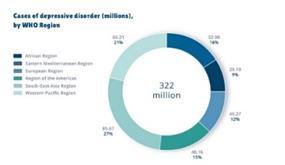
b) AnxietyDisorders-Stressissomethingthatcanbe caused by almost anything. But when this stress turns into fear, one starts feeling ‘anxious’. This uneasy feeling is what is termed as anxiety .It is prettynormaltofeelanxious.Thisfeelingnormally comes and goes, not enough to hinder your everydaywork.Butifthefearstayswithyouallthe time, becomes overbearing and intense, that is when it becomes a disorder. Anxiety is not pertained to one area but rather a vivid range. Different people have different anxiety problems thattheyfaceonadailybases.Itisnotnecessary that the symptoms and effect for everyone is the same.
Thereforethereareseveralanxietydisorders like:
PanicDisorders:oneexperienceswhatis termedasa‘panicattack’,basicallywhere thepersonis renderedhelplessandis unable to react or get out of an intense episodeofsuddenfear.Usuallylastsfora fewminutes.
Phobia:fearofanobject,situation,person oranactivity.
Social anxiety: what teenagers call being ‘socially awkward’ these people always fearsocialinteractionsastheyarescared ofbeingjudgedby others.
Separation anxiety: scared of being away fromsomeoneorsomethingwhetheritis a person,your homeorsomeobject.
AccordingtoWHO,peoplewithanxietydisordersmakeup around3.6%oftheworldpopulation.Around260million people in the world live with anxiety disorders, what is frighteningisthenumberkeepsincreasingeveryyear.
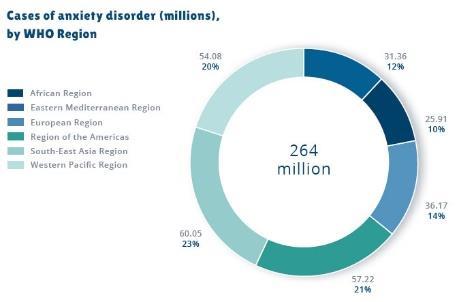
c) PostTraumaticStressDisorder(PTSD)-Knownto be triggered byexperiencinga terrifying eventor even by witnessing it. Everyone goes through a roughpatchorexperiencesa‘trauma’atsomepoint in their lives. While some people recover , others carry it for the rest of their lives, thus getting diagnosed with PTSD. People with PTSD can get flashbacks of the event from time to time and anything related to the incident can trigger the condition.
InapreviousWHOstudyof21countries,morethan10%of respondents reported witnessing violence (21.8%) or experiencing interpersonal violence (18.8%), accidents (17.7%),exposuretowar(16.2%)ortraumatoalovedone (12.5%).Anestimated3.6%oftheworld'spopulationhas sufferedfrompost-traumaticstressdisorder(PTSD).
d) Schizophrenia–Itisquiteaseriousmentalhealth conditionthathinderstheoverallabilityofaperson to think and behave. It is a disorder that needs immediate and thorough medical attention at all times.Behaviour wise, the personmay experience aggression, loneliness,social isolation which can trigger incidents of hallucinations, self-harm, paranoiaandevenmemorylossinsomecases.
WHO states that around 24 million (1 in 300) peopleareaffectedworldwideeveryyear.

International Research Journal of Engineering and Technology (IRJET) e-ISSN: 2395-0056
Volume: 11 Issue: 07 | July 2024 www.irjet.net p-ISSN: 2395-0072
Following information is about how music therapy has helped better the condition of people with anxiety, depression, PTSD and schizophrenia. It is from different researchpapersthatcarriedouttheseexperiments.
• ForDepression:
AnarticlewaspublishedinTheBritishJournalofPsychiatry where trials were conducted to test the effect of music therapyondepressionamongworking-agepeople.
Around 79 people participated it.Out of whicharound 33 people were assigned to music therapy while others had theirnormaltreatmentgoingon.Theclientswerefiltered onthebasisofseveralcriterialikeiftheyweresuicidal,had acuteorseveresubstancemisuse,iftheyhadlessknowledge ofthefinnishlanguage(thetrialswereconductedinfinland henceknowingfinnishwasnecessary).thetrialstookplace in t the Music Therapy Clinic for Research and Training, UniversityofJyva¨skyla¨,Finland.Thistrialtookplaceinthe year2008.
A)Method
Psychiatricassessmentswereconductedin3and6months followuponeafterthemusictherapyandanotheroneafter the program was over.All these assessments were carried out by a masked clinical psychiatric expert.A total of 20 musicsessionswereconductedtwiceaweekeachofthem lasting for about 60 minutes.The sessions were based on expressing themselves through music using a mallet instrument,apercussioninstrumentoranacousticdjembe drum.The therapist and the client both had musical instruments which they played and used it as a means of communication.Thiscanbe anexample ofNordoff-Robins MusicTherapyasdiscussedabove.Thesessionswerevideo recordedatalltimesforsupervisionandfurtherstudying.
B)Observations
There were two follow ups, a 3 month follow up and a 6 monthfollowup.Soduringthe3monthfollowupthedata wasasfollows-(onMontgomeryDepressionScale)
MusicTherapygroup-
• n=67
• Mean=14.10
• MeanDifference=4.65
• Ttest=2.29
• P=0.03
Controlgroup-
• n=67
• Mean=16.43
• MeanDifference=4.65
• Ttest=2.29
• P=0.03
6monthfollowup-
MusicTherapygroup-
• n=64
• Mean=14.48
• MeanDifference=3.44
• Ttest=1.53
• P=0.13
Controlgroup-
• n=64
• Mean=14.74
• MeanDifference=3.44
• Ttest=1.53
• P=0.13
C)Results
This trial shows that music therapy does have a positive effectonone’smind,Thepeopleinthemusictherapygroup significantlyimprovedtheirmentalwellbeingascompared to the control group. The effect size was about 0.65 for depressionand0.49foranxiety.TheNNT(No.neededtobe treated)was4meaning1in4personstendtoimprovetheir conditionthroughmusictherapy.
• Foranxiety:
A paperwaspublished byCanadianCentreofScienceand Education in the year 2019, termed as ‘effect of classical music therapy on anxiety and well-being of university students.’Atotalof15students(7females,8males)fromthe departmentofGuidanceandPsychologicalcounsellingatthe University of Kafkas, Turkey participated in this trial. The selection criteria was that around 50 students were observed according to the Psychological well being and Trait-Scaleandthestudentswithrelativelyhigheranxiety levelswereselected.
A)Method
Asthe15studentswereselected,sixworksofMozartwere downloaded in their phones with their consent, To make sure,theyarelisteningtothemusic,theyweresupposedto filltheirMusiclisteningscheduleeveryday.Attheendof60 daystheState-TraitAnxietyInventoryandthePsychological Well-beingScalewereadministeredagain.
B)Observations
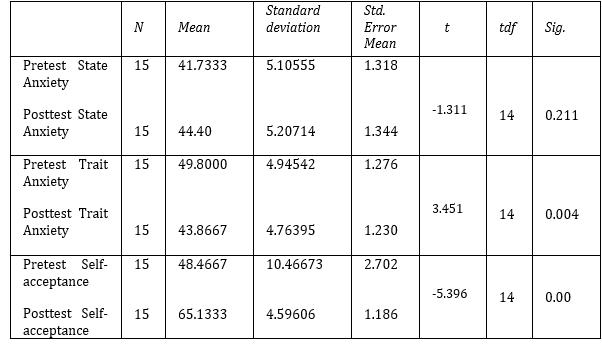
Table -1

International Research Journal of Engineering and Technology (IRJET) e-ISSN: 2395-0056
Volume: 11 Issue: 07 | July 2024 www.irjet.net p-ISSN: 2395-0072
C)Results
Asseeninthetableabove,beforeandafterchangescanbe seen . While the changes are quite noticeable for some criterias, others are not that affected by it. For example, thereisalittledifferencebetweenthepretestandposttest stateanxiety,butthereisnoticeabledifferencebetweentrait anxiety. Also, pretest and postest positive relations with others and self acceptance criteria shows the most significantdifference.Rightfrom57.933themeanincreased toaround70.6andfrom48.466to65.133respectively.Thus ,we can conclude that music therapy indeed helps in betteringtheconditionofamentalhealthpatient.
• ForPostTraumaticStressDisorder(PTSD)
AlthoughtherearealotoftreatmentsavailableforPTSDlike CognitiveBehavioralTherapy(CBT),TF-CBT;
Cohen,Kliethermes,Mannarino,&Murray,2012),Cognitive ProcessingTherapy(CPT;Foaetal.,1999),EyeMovement Desensitization and Reprocessing Therapy however they are considered to be time consuming, require proper medical facilities . Music Therapy on the other hand is considered to be much simpler and effective. Therefore severaltrialshavebeenconductedtotreatPTSDwithMusic Therapy.
A)Method
WhenresearchedaboutpeopleaffectedbyPTSD,most of them were 18 years or older and had been subjected to serioustraumaintheirlives.Followingisthecompilationof thestudiesconducted bydifferentinstitutionsandpeople andwhatwastheoutcomeofit
B)ResultsandObservations
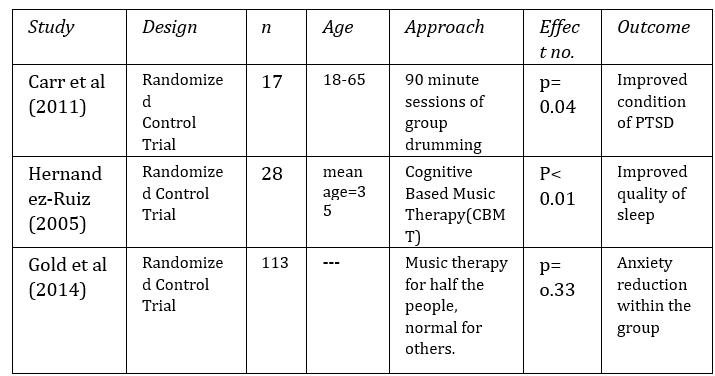
Table-2
• ForSchizophrenia
Followingobservationsaretakenfromapapertitled‘Music therapyforin-patientswithschizophreniaMusictherapyfor in-patients with schizophrenia’ published in the British journalofPsychiatry,aworldrenownedjournal,intheyear 2006.This paper particularly tells us more about schizophreniaandhighlightshowuseofmusictherapycan havecertaineffectsontheaffected.Overall,thewholesurvey
wentonforaround3monthswith115eligiblepatientsout ofwhich85(70%ofthem)wererandomized.
A)Method
Overthecourseof12weeks,patientswhenthroughmusic therapyalongwithstandardcarewhichwasthencompared withthemreceivingonlystandardcare.Nowtheparticipants werefilteredandchosenonthebasesofvariousthings.They were in patients from the hospitals in central and inner London- Park Royal Centre for Mental Health, Paterson Centre,StCharles’HospitalandStClement’sHospital.Thelot consistedofpatientsover18yearsprimarilydiagnosedwith schizophrenia or schizophrenia like symptoms , patients with severe conditions and ongoing treatment as long as theyconsenttothetrials.Addingtothis,overthecourseof thesetrialspatientswouldonlybeexposedtomusictherapy and not any other art therapies like dance, drama etc. for greatereffects.Participantshadtoattendatleastfourmusic therapy sessions and were free to attend more if they wanted.Fivemusictherapistswereappointedforthesame. The sessions took place weekly, lasting around 45 minutes.Patientswereencouragedtotakeupaninstrument andstartexpressingthemselvestoit.Thiswouldallowthe therapisttocloselymonitorthemonthebasisofwhatthey play.Thetherapistalsoplaysalongwiththepatient,trying to meet their emotional state through music.All these sessions were recorded for future observations.However, patientswereencouragedtocontinuethesepracticeseven afterthecompletionofthetrials.
B)ResultsandObservations
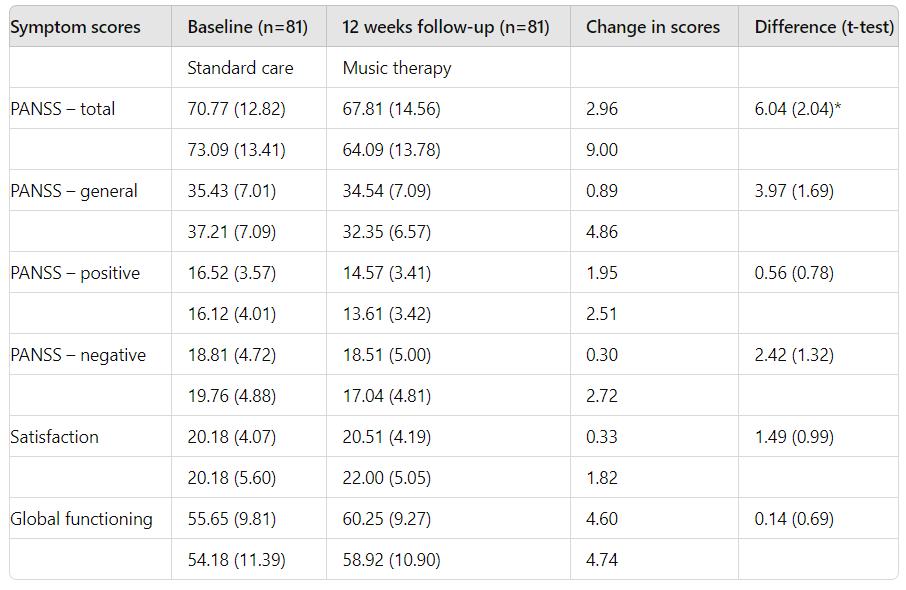
Table-3
Duringthestudyperiod,123peoplewerescreened,and113 (92%) were deemed eligible to participate . Among the eligiblepatients,31(27%)declinedtojointhestudy,and1 (1%) was found unsuitable for music therapy after an assessmentbyamusictherapist.Thetableaboveindicates the major findings in their paper which talks about the condition of the patients before and after starting music therapy.Itistobenotedthattheresultswereassessedbased

International Research Journal of Engineering and Technology (IRJET) e-ISSN: 2395-0056
Volume: 11 Issue: 07 | July 2024 www.irjet.net p-ISSN: 2395-0072
on the PANSS scale. It basically stands for Positive and Negative Syndrome Scale which is specifically used for symptommeasuringinschizophrenicpatients.Theseverity ismeasuredfromrangeof1to7with1beingnonexistent and 7 being extreme.Here, it is basically based on the averagescore,whetherithasgonedown,andifyes,thenby howmuch.Ifyoucomparetheresultsofonlystandardcare versusresultsofstandardcareplusmusictherapy,decrease in numbers can be seen.For example the PANSS-total for standardcarebefore12weeksis70.77andafter12weeksis 67.81.Now,thereisadifferenceof2.96sowecansaythatthe situation improved by that much, which is a really good thing.But,ifwelookatthePANSS-totalformusictherapy,itis 73.09 before the sessions and 64.09 after.There is a differenceofabout9.00whichisaverysignificantchange that has occurred , almost thrice more than in the case of standard care. If we look at the other cases as well music therapyasatreatmentdefinitelyprevailsduetothevisible differenceinthevalues.Therefore,wecansaythisresearch provedtobequiteasuccess.Asaresult,patientswhowerea partofthisprogramwereadvisedtocontinuethispractice.
As mentioned above, we can see that in all the four cases there is a positive change observed ,significant in some cases, little in others.However, it can definitely act as a buildingblockforfurtherresearch.
As mentioned above, we can see that in all the four cases mentioned about Depression, Anxiety, PTSD and Schizophrenia respectively, there is a positive change observed.Althoughtheyaresignificantinsomecases,little inothers,theirdataandobservationscandefinitelyactasa building block forfurtherresearchHence,wecansaythat MusicTherapyindeedplaysamajorroleinuplifting one’s mental health.It can thus be considered as a treatment optionandmoreandmorepeopleshouldbeeducatedabout it.It isnotonlyaboutcuringmentalandphysicaldisorders but also about simple things like uplifting one’s mood or easingmuscletensionoreveninloweringourheartrateand bloodpressure.Beingsuchasimpleconceptitcanbeeasily implemented.Ihopethisreviewpaperservesasamedium toencourageeveryonetoknowmoreaboutmusictherapy andthusinspirefurtherstudyforthesame.
I would like to thank my college i.e. Thakur College of EngineeringandTechnologyfororganizingMulticon-W,an international paper conference and giving me this opportunitytowritemyownpaper.Furthermore,Iwould liketo expressmy gratitude towards myfriends, teachers and everyone who has helped me in this journey. This couldn’t have been possible without them and therefore I thankthemwithallmyheart.
[1] https://www.ptsduk.org/music-therapy-for-ptsd/
[2] https://www.verywellmind.com/benefits-of-musictherapy-89829#toc-benefits-of-using-music-as-therapy
[3] ErkkiläJ,PunkanenM,FachnerJ,Ala-RuonaE,PöntiöI, Tervaniemi M, Vanhala M, Gold C. Individual music therapyfordepression:randomisedcontrolledtrial.BrJ Psychiatry. 2011 Aug;199(2):132-9. doi: 10.1192/bjp.bp.110.085431. Epub 2011 Apr 7. PMID: 21474494.
[4] https://apps.who.int/iris/bitstream/handle/10665/25 4610/WHO-MSD-MER-2017.2-eng.pdf
[5] TheEffectofClassicalMusiconAnxietyandWell-Being ofUniversityStudentsDevrimERGINSOYOSMANOĞLU1 & Hüseyin YILMAZ21 Department of Educational Sciences,FacultyofEducation,KafkasUniversity,Kars, Turkey.
[6] https://scholar.google.com/
[7] https://www.who.int/health-topics/#A
[8] https://www.who.int/news-room/factsheets/detail/mental-disorders
[9] AalbersS,Fusar-PoliL,FreemanRE,SpreenM,KetJC, VinkAC,MaratosA,CrawfordM,ChenXJ,GoldC.Music therapy for depression. Cochrane Database Syst Rev. 2017 Nov 16; 11 (11): CD004517. doi: 10.1002/14651858.CD004517.pub3.PMID:29144545; PMCID:PMC6486188.
[10] TalwarN,CrawfordMJ,MaratosA,NurU,McDermottO, Procter S. Music therapy for in-patients with schizophrenia:Exploratoryrandomisedcontrolledtrial. British Journal of Psychiatry. 2006;189(5):405-409. doi:10.1192/bjp.bp.105.015073
[11] https://www.cambridge.org/core/journals/the-britishjournal-of-psychiatry/article/music-therapy-forinpatients-withschizophrenia/F022B368112A712DD64E745A536AEF8 8